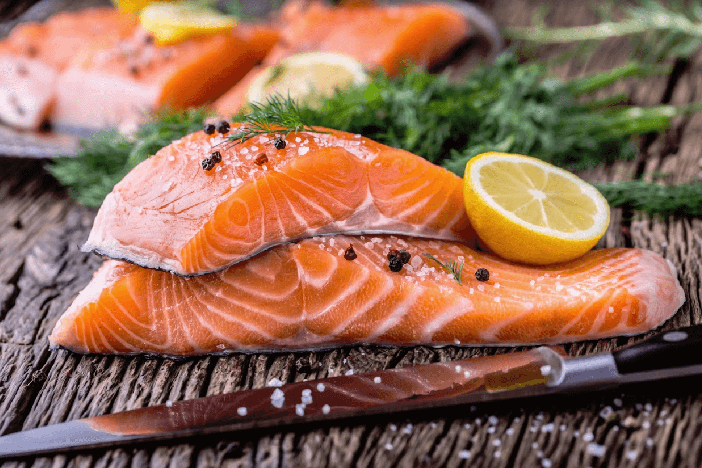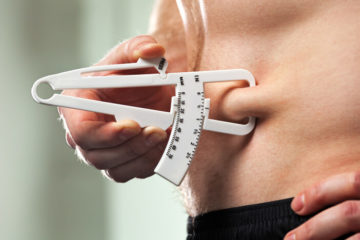Fat and Fatty Acids - all about the macronutrient with the highest energy density.

Functions of Fat
Fat, along with protein and carbohydrates, is one of the three macronutrients and has many functions in the human body. Its most important function is to provide the body with energy. Fat provides the body with double the amount of energy per gram as protein and carbohydrates. Our bodies are constantly burning fat. The body uses the lipid metabolism to circulate energy around the body to provide it with a constant supply. A further function of fat is the absorption of vitamins A, D and K which must be dissolved in fat before they can enter the body and be further processed.
Fat is also a building material for cells, above all for the cell membrane. This is a constantly occuring process so a constant supply of fat is essential. Excess fats, similarly to excess carbohydrates, get stored in the energy reserves. The fat deposits also have important functions: In extreme situations the body is able to run off these fat reserves for up to forty days. If the body isn’t supplied with foods containing fat for a period of time, the fat cells are burnt to provide energy. Fat also keeps the body warm and protects against hypothermia.
Which food products contain fat?
Fats are found in animal and plant products. The way animals use and store fat is very similar to that of humans, because animals also have a layer of fat under their skin. For animals: adequate movement, healthy nutrition and ethical rearing, correlate with a low body fat percentage. Plant products that contain a lot of healthy fats are nuts and seeds and avocados. Plant based fats contain a high percentage of unsaturated fatty acids.
Saturated and unsaturated fatty acids
Fats found in foods come in various forms. As a rule, these fats are triglycerides and contain fatty acids, which can be subdivided into short-, middle- and long-chain fatty acids. These can then be further categorised as mono- and poly- unsaturated fatty acids as well as saturated fatty acids. These fatty acids differentiate themselves first and foremost in their functions. Saturated fatty acids are easy to process and quickly make their way into the blood circulation, the so called “blood lipids”. They have antibacterial properties and help fight against bacterial infections. The mono and poly unsaturated fatty acids have a positive effect on the energy- and lipid metabolisms. They also help the carbohydrate metabolism, by increasing insulin sensitivity. Both of these are important factors if you want to lose weight.
Saturated fatty acids also have a positive effective on our bloodpressure and protect the cell membrane. Polyunsaturated fatty acids are essential fats, meaning that the body needs them but can not produce them on its own, ie. must obtain them from food. They can be found in oily fish such as salmon, which is rich in Omega-3 and Omega-6 fatty acids. The configuration and distribution of fatty acids goes back to how the animals were raised. So as long as you pay attention to the quality of the meat/fish you are eating, a moderate consumption will provide you with a good amount of Omega 3 Fatty acids.
Monounsaturated fatty acids are found in plant oils. Each oil has a unique fat composition. The absolute blockbuster of plant oils is linseed oil because it is particularly rich in Omega 3 fatty acids. Hempseed and Rapeseed oils also have a good ratio of Omega 3 to Omega 6 fatty acids. Whilst Omega 3 fatty acids have many health benefits, for example for the heart circulatory system, Omega 6 fatty acids can bring about negative side effects such as inflammation. Intensively reared livestock and processed meat products contain a higher percentage of Omega 6 fatty acids and should be avoided. You can use the Upfit BMI and Nutrition Calculator to calculate how much fat you should be consuming each day.
Trans fats and cholesterol
The one type of fatty acids that you should completely stay away from, is the trans fatty acids, namely the chemicaly modified fatty acids. Trans fats are used to harden foods which are liquid at room temperature. Trans fatty acids are often found in fried products such as french fries, fried chicken, chocolate, margarine and crisps. Food products which contain trans fats should therefore only be consumed in small amounts. Cholesterol is actually not a fat but a substance which is similar to fat. Cholesterol is important, since it is a basic form of many vitamins and plays an important role in bile acid as well as various hormones. The so called cholesterol level should keep cholesterol available in the body at all times. Many people want to reduce their cholesterol level. There are two types of cholesterol, HDL and LDL. Just as with Omega 3 and 6 fatty acids, it is important that the relationship between them is correct.
The classic cholesterol containing food is undoubtebly the egg. Despite the longstanding rumours, studies have now shown that eggs and other foods do not increase cholesterol in the human body. Our bodies cannot absorb cholesterol from outside sources, unless the cholesterol levels are very low. Cholesterol in its pure form therefore plays little role. Unsaturated fatty acids on the other hand have a larger impact on cholesterol levels. Monounsaturated fatty acids improve the balance of cholesterol whereas the polysaturated fatty acids reduce the overall levels. Trans fatty acids raise LDL levels, namely the ‘negative’ cholesterol and reduce the HDL, ie. the ‘positive’ cholesterol. Neither form of cholesterol is inherently good or bad. If your cholesterol is too high, concentrate on the relationship between the two types and the other blood fats as well as their values. For further information you should speak to your doctor.
Learn all about cholesterol and how you can lower your cholesterol level – naturally.
How much fat do I need?
As with the other macronutrients, how much fat a person needs depends on the overall amount they eat. A good rule of thumb is to obtain 25-30% of your calories from fat. For sportspersons, this can be increased to up to 40%. Various diet forms such as the low carb diet or vegan diet advocate different amounts of fat. Whichever diet you follow, it is important to cover your basic fat needs. You should also remember that fat doesn’t just get stored from eating fatty foods but also from eating too many carbohydrates. Since fat is often directly burned and carbohydrates are a pure source of energy it is easier to overeat on carbohydrates and the excess calories will get stored as fat.
Summary of fats and fatty acids
Fat is an important supplier of energy and is used in cell membrane production, vitamin absorption and to protect the organs. Since fat is the most energy dense of the macronutrients, you must be careful not to eat too much of it. Both saturated and unsaturated fatty acids are important for the body and should be consumed daily. However, you should avoid trans fats since these play havoc with your cholesterol levels.



